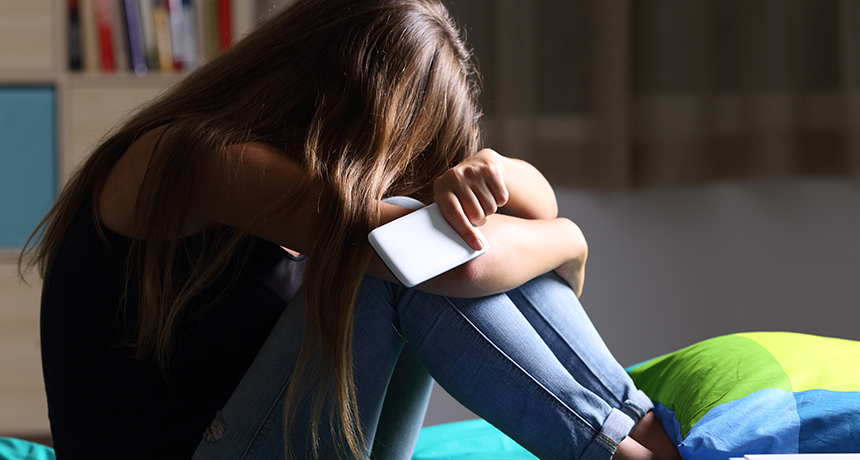Not all social media sites are equally likely to provoke anxiety
Some apps are more stress-inducing than others, teen finds

Does social media trigger anxiety? A teen’s data show that people do not respond the same way to all social media sites.
ANTONIOGUILLEM/ISTOCKPHOTO
Share this:
- Share via email (Opens in new window) Email
- Click to share on Facebook (Opens in new window) Facebook
- Click to share on X (Opens in new window) X
- Click to share on Pinterest (Opens in new window) Pinterest
- Click to share on Reddit (Opens in new window) Reddit
- Share to Google Classroom (Opens in new window) Google Classroom
- Click to print (Opens in new window) Print
PITTSBURGH, Pa. — From exams to the horrors of school shootings, high school students have plenty to be anxious about. By comparison, social media — Instagram, Snapchat and Twitter, for instance — might seem like escapes. But Alisha Goyal, 18, wondered if social media sites might end up being more stressful than soothing. The senior at Hamilton High School in Chandler, Ariz., surveyed teens to discover if social media tends to hurt or help. Her findings now suggest that people who hang out at some social media sites might be at risk of developing anxiety.
Social media is a fact of life for teens. “Nowadays you can’t tell a teenager not to use [it],” Alisha says. “Almost 94 percent are using social media daily.” The teen wanted to assess the impacts of these sites on herself and her friends. She particularly wanted to study anxiety, she says, because it’s such a common mental illness and often develops during adolescence.
Anxiety disorders — disorders that are associated with anxiety and fear, even when there’s nothing to be afraid of — are indeed very common. Slightly more than three in every 10 U.S. teens have anxiety disorders. We’re not talking about the butterflies you get before a big speech. People with anxiety disorders may develop tense muscles or trouble sleeping. They might suffer from feelings of panic. If these feelings don’t go away, they can stop people from going to school or participating in events they enjoy.
Alisha wanted to look for potential links between use of social media by teens and risk of anxiety disorders. She had been working with Yonas Geda. He is a psychiatrist — a doctor who treats mental illnesses — at the Mayo Clinic in Scottsdale, Ariz. Together, they adapted a test for anxiety in social situations. It had been developed for use by for adults. They made it into a survey about social media and anxiety that would be suitable for teens.
Social media sleuthing
The survey asked teens how much time they spent on Facebook, Twitter, Instagram and Snapchat. It also asked why the teens went to these sites and how they used these types of social media. For instance, they might prefer to be active (posting), interactive (liking and commenting) or just remain passive (scrolling through).
The questions also asked the volunteers about their levels of anxiety. Would they feel comfortable giving a public speech, for instance? The questions could not diagnose anxiety. Instead, they helped determine if someone was likely to develop an anxiety disorder at some later date.
To get the word out, “I emailed all the teachers in my school and asked them to give out the survey,” Alisha says. She attends a big school and ended up with 1,000 responses.
Facebook may make big headlines, but it’s not all that popular with teens, her data show. Use of Facebook also was not linked with someone’s score on the anxiety test. Twitter and Snapchat both seemed fairly relaxing. Teens who spent a lot of time on those sites scored lower on the anxiety test. That suggests they might be less likely to develop an anxiety disorder later.
Instagram showed the opposite trend. People who used this site scored more highly on the anxiety test. They could be more likely to suffer from anxiety later, Alisha says.
The teen shared her results at the Intel International Science and Engineering Fair (ISEF), three weeks ago. The annual competition brought together almost 1,800 students from 81 countries. They presented their science fair projects to the public and competed for some $5 million in prizes. (ISEF was created by Society for Science & the Public. This year it is sponsored by Intel. The Society also publishes Science News for Students and this blog.)
Interpreting her findings
What Alisha turned up was a correlation — a link between two things. Time spent on Instagram was correlated with higher scores on questions asking about anxiety. But that doesn’t mean that Instagram causes anxiety, Alisha notes. Why? Certain platforms might attract more people who tend to be anxious, rather than prompting their visitors to become anxious. All her study can show is an association.
Why might use of different social media sites lead to different anxiety scores? Alisha thinks that how people interact with social media matters. With Snapchat, for example, “you’re having person-to-person conversations,” she says. “You’re not afraid to put on an ugly filter.” So Snapchat might make it easier to be yourself. On Twitter, people create their own tweets, sharing their thoughts with all they follow. That might help relieve stress, the teen thinks.
But Instagram is different. Each posted picture goes out to the entire universe of Instagram followers. People on the platform interact a lot, and each “like” or comment is open for all to see. “You see people project their best self,” Alisha says. The pressure to produce the perfect picture — gaining the most likes and best comments — can be intense, she adds.
Alisha is working on getting her anxiety test published in a scientific journal. She hopes that someday her results might help doctors detect emerging anxiety in teens. For now, she says, “I stopped posting on Instagram completely.” She probably didn’t need the extra stress.







